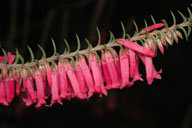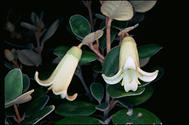 |
Australian National Botanic Gardens |
 |
A weekly news sheet prepared by a Gardens' volunteer.
Numbers in square brackets [ ] refer to garden bed Sections.
Plants in flower are in bold type.
16 July 2010
 |
Epacris impressa click for larger image |
Today we are going to the Rock Garden. Leave the Visitors’ Information Centre and notice on the right the bright pink tubular flowers of Epacris impressa [Section 174] clustered on long stems. Follow the Main Path across the bridge where you will notice on both the right and left Asterotrichion discolor [Sections 66 and 305] from the wet forests of Tasmania with five part white flowers on a straggly tree. The flowers have a strong rather musty scent. Skirt the café to see another heath Epacris longiflora.
[Section 131] in the Ellis Rowan Garden with spectacular deep red tubular flowers with white tips hanging on a small open bush. On the right is Acacia alata var. biglandulosa or Winged Wattle [Section 240] with lovely cream balls on flattened phyllodes. Leave the Main Path here and turn uphill towards the Brittle Gum Lawn.
On the right is Thryptomene ‘Pink Lace’ [Section 10] with arching stems of small pink flowers. Also on the right is Eremophila maculata subsp. maculata [Section 302] with bright yellow tubular flowers on a small green bush. Further along are several bushes of Eremophila microtheca [Section 302] with mauve bells on an airy grey green bush. You can smell these bushes before you see them – the minty fresh smell of eremophila. Bear left towards the Rock Garden and go straight up the steps.
Banksia integrifolia subsp. integrifolia [Section 15c] is on your left with its scrambling vigorous foliage of dark green silver-backed leaves. The cones are fresh lemon yellow upright amongst the foliage. On the right is Correa ‘Ivory Bells’ [Section 15e], a rounded bush with many cream bells. Turn right on the second path after the steps into Section 15f noting on the left the unusual Homoranthus darwinioides [Section 15f] with tiny cream and pink bells on a sparsely foliaged bush. Continue across the bridge to see Banksia ‘Birthday Candles’ [Section 15m] on your left, a green mound of foliage with densely packed golden candles.
On the right is Dryandra fraseri var. fraseri [Section 15p], a small plant with spidery foliage and gold cups of blossom. Also on the right is Hakea corymbosa or Cauliflower Hakea [Section 15p], an incredibly prickly bush with rounded ‘cauliflower’ head of greenish cream blooms. On the left is Leucopogon fraseri [Section 15k] with tiny pink bells on a small dense bush.
 |
Correa 'Ivory Bells' click for larger image |
Near the seat as you leave the Rock Garden on your left is Grevillea sp. [Section 14] with long toothbrush red flowers spilling down from the rocks. Look above to see Eremophila oppositifolia [Section 14] in full bloom with hundreds of cream and dark pink bells on a grey bush. Head back downhill on the Main Path. Opposite the waterfall on the left is Guichenotia ledifolia [Section 4] with lovely dusky pink bells hanging from a grey bush. Further down on the left is Lysiosepalum involucratum [Section 4] a rounded bush with attractive pinkish orange buds opening to purple hanging star flowers. Also on the left is the Wilga tree Geijera parviflora [Section 4] showing clusters of tiny white flowers on slender pendent foliage. The foliage will often droop to the ground if not trimmed by animals. Our last plant is also on the left, Melaleuca rhaphiophylla or Needle Leaved Honey Myrtle [Section 10] with small fluffy white flowers on fine foliage. Continue down the hill towards the Visitors Information Centre.
Rosalind Walcott